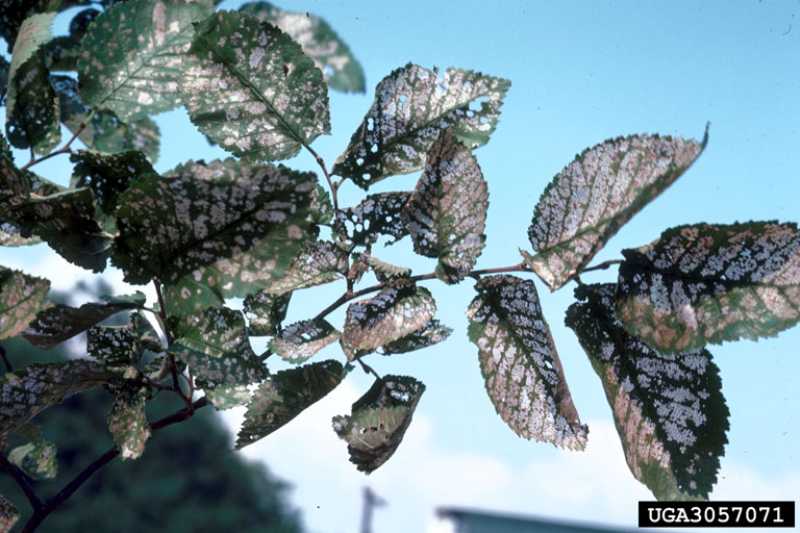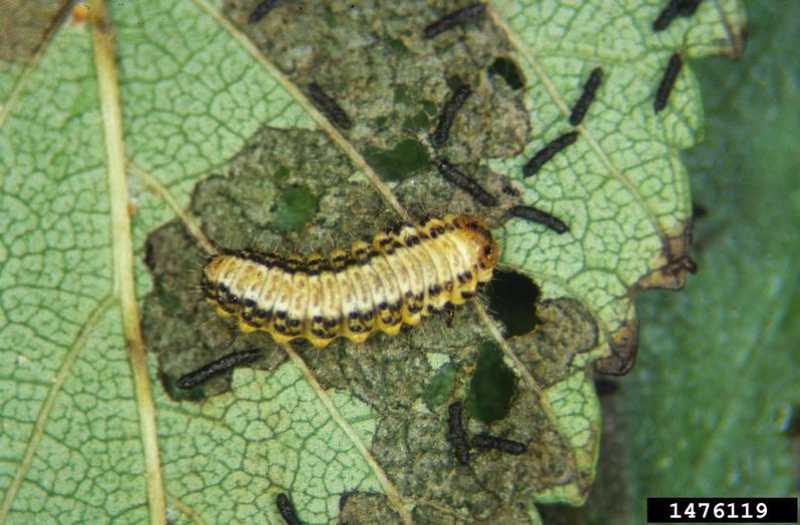Scientific Name: Xanthogallerucae luteola
Order: Coleoptera Family: Chrysomelidae
Identification:
Eggs – Eggs
are yellowish to gray and lemon shaped. Females lay them in clumps or double
rows of about 10 to 30 on the underside of elm leaves.
Larvae - Larvae are black when newly hatched. After feeding, they become a dull yellow or green with rows of tiny dark projections and a pair of black stripes down the back. They are slug like and reach a length around ½ an inch.
Pupae - Pupae are ¼ an inch long and yellow. They are often found in litter on the ground or near the base of elm trees.
Adult - Adults are yellowish to olive-green with black stripes along the outer margin of each wing cover (elytra). They are about ¼ an inch long
 Life Stages: Elm leaf beetles have complete
metamorphosis and there are 2 complete generations per year in Canada.
Females lay 400-800 eggs which hatch in approximately one week.
The subsequent larvae go through three growing stages (instars) while eating
the underside of leaves.
This growing process takes approximately 2-3 weeks and when finished the larvae
crawl down the trunk of the tree to pupate (form cocoons) at its base.
Adult beetles emerge within two weeks and fly back to the leaves to eat and lay
eggs.
Adults often seek overwintering protection in or near homes. Though they do not
reproduce indoors and harmless, they can become active again during warm winter
days.
Life Stages: Elm leaf beetles have complete
metamorphosis and there are 2 complete generations per year in Canada.
Females lay 400-800 eggs which hatch in approximately one week.
The subsequent larvae go through three growing stages (instars) while eating
the underside of leaves.
This growing process takes approximately 2-3 weeks and when finished the larvae
crawl down the trunk of the tree to pupate (form cocoons) at its base.
Adult beetles emerge within two weeks and fly back to the leaves to eat and lay
eggs.
Adults often seek overwintering protection in or near homes. Though they do not
reproduce indoors and harmless, they can become active again during warm winter
days.
Types of Plants Affected: Elms (i.e. English
Elm, Scotch Elm, Siberian Elm, etc.)
Type of Damage: Larvae skeletonize
the leaf’s underside surface, while adults chew entirely through the leaf,
often in a shot hole pattern. As damage
accumulates, dry, skeletonized leaves become obvious. Heavily infested trees have sparse foliage, and
remaining leaves take on a rusty, reddish brown tint. Adults also try to overwinter inside homes by going through cracks.
Control Methods:
Cultural:
Seal
up any cracks in houses and install
screens by mid-August to prevent adults from overwintering inside. If they do
get in, vacuum them up.
Physical:
Some
say elm beetles can be pressure washed off branches with a soapy spray,
however, this is not proven by study.
Rake or use a shop vacuum at the base of a tree to get rid of some pupae or
larvae.
Biological: Natural
enemies include birds, toads, diseases and predaceous or parasitic insects. One parasitic wasp, Oomyzus gallerucae, has been very successful at killing elm leaf
beetle larvae. However, it has had a hard time establishing itself past one
season in North America.
 Chemical: Tree banding the infected tree with insecticide
right before the first generation of larvae crawl down the trunk to pupate is the
most effective method (late June to early July). Unfortunately, some damage will already be done by
the first generation, but it will be limited. Also, in order to prevent beetles
from migrating, whole communities should spray trees. Two spraying sessions
will be needed in May and July or August to kill both generations. Some effective
chemicals to be used are: Sevin (carbaryl), Spinosad and Ortho Bug-B-Gon Max (Carbaryl).
Chemical: Tree banding the infected tree with insecticide
right before the first generation of larvae crawl down the trunk to pupate is the
most effective method (late June to early July). Unfortunately, some damage will already be done by
the first generation, but it will be limited. Also, in order to prevent beetles
from migrating, whole communities should spray trees. Two spraying sessions
will be needed in May and July or August to kill both generations. Some effective
chemicals to be used are: Sevin (carbaryl), Spinosad and Ortho Bug-B-Gon Max (Carbaryl).
REFERENCES
Center
for Invasive Species Research, University of California, Riverside (2001). The Elm Leaf
Cranshaw,
W.S. (2011). Elm Leaf Beetles no 5.5.21. Colorado
State University Extension.
Dahlsten
lab home (2004). Elm Leaf Beetle. Retrieved
from
Health
Canada (2011). Consumer Safety-Pesticides
and Pest Management-Product Label. Retrieved from
Home
and Garden Information Centre (1992). The
Elm Leaf Beetle. Maryland Cooperative Extension,
University of Maryland. Retrieved
from http://www.hgic.umd.edu/_media/documents/hg113_000.pdf
Island
Crop Management(2007). Elm Leaf Beetle. Retrieved
from
North
Carolina Cooperative Extension (2001). Ornamentals
and Turf, Department of
Entomology
Insect Note. Retrieved
from http://www.ces.ncsu.edu/depts/ent/notes/O&T/trees/note85/note085.html
Pest
Management Grant, Final Grant, Contract #97-0274 (04/1/99). Implementation of the
Integrated
Pest Management for the Elm Leaf Beetle, Xanthogallerucae luteola
(Chrysomelidae:
Coleoptera),in a Large Urban Area (Sacramento). Retrieved from http://www.cdpr.ca.gov/docs/pestmgt/grants/97-98/finlrpts/97-0274.pdf
Seattle
Community Network. Elm Leaf Beetle HOWTO.
Retrieved from http://www.scn.org/~bk269/elms.html
Solomon,
James (04/21/11). Elm Leaf Beetle
Xanthogallerucae luteola (Muller, 1766). USDA
Forest Service, Bugwood.org.
Retrieved from
Thurston,
Graham S. (1998). Biological Control of
Elm Leaf Beetle. Retrieved from
UC IPM
Online, (2004). Statewide Integrated Pest
Management Program. Retrieved from http://www.ipm.ucdavis.edu/PMG/PESTNOTES/pn7403.html
Utah
State University Cooperative Extension, (2000). Elm Leaf Beetles, Fact Sheet No. 22.

No comments:
Post a Comment